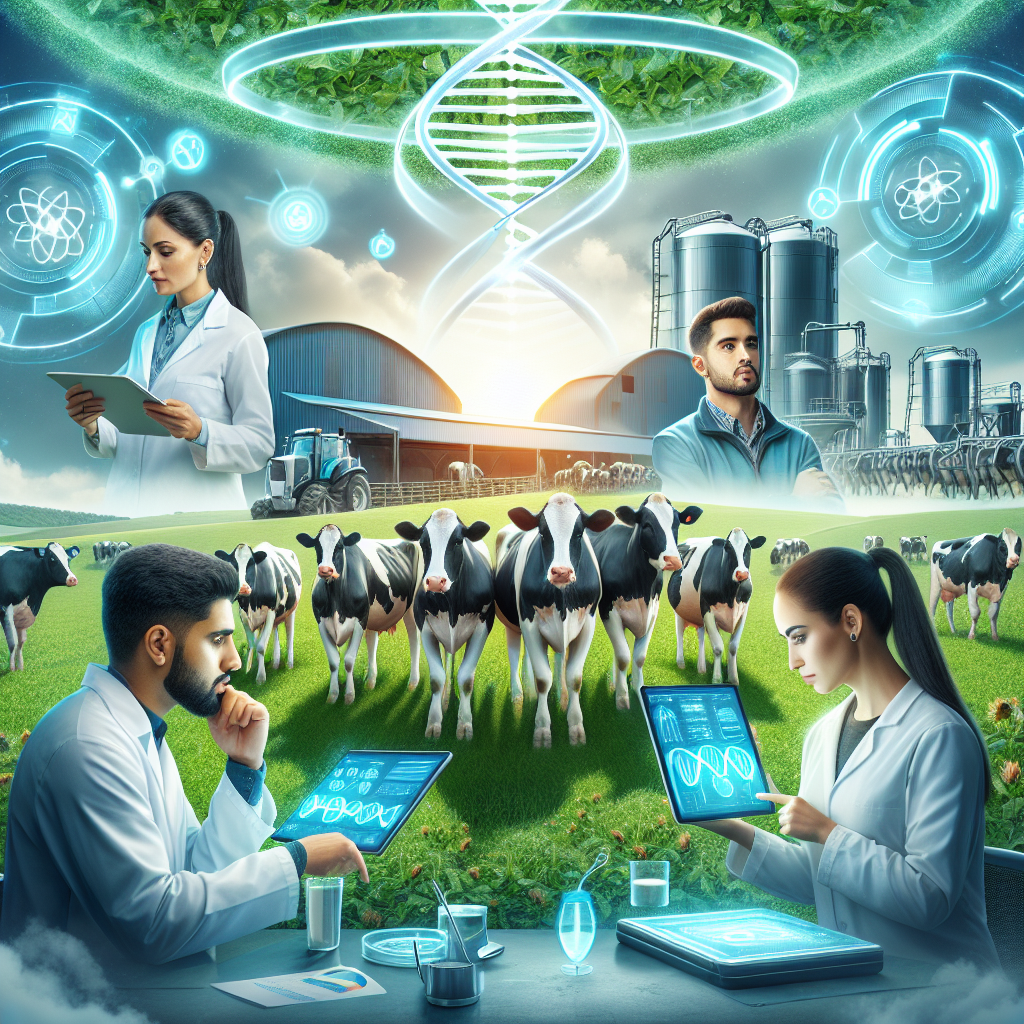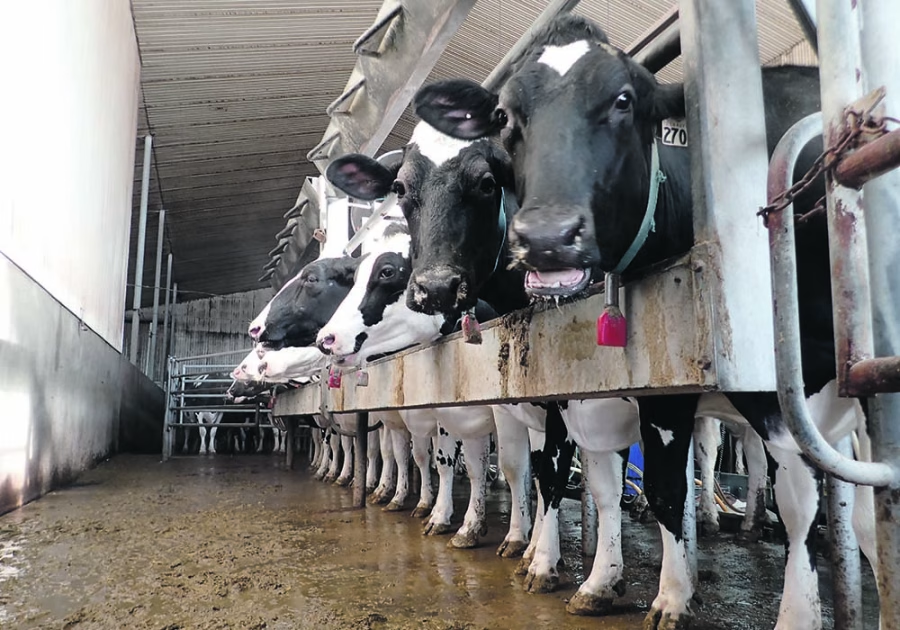Boost your dairy herd’s fertility with cutting-edge genetic selection. Discover how modern techniques can enhance pregnancy rates and streamline your farm’s operations.

Consider a dairy farm where cows get pregnant shortly after calving with minimum manipulations. This is not a pipe dream; deliberate fertility selection may make it a reality. High fertility in dairy farming leads to shorter calving intervals, improved milk production cycles, and increased profitability.
Rapid pregnancy following calving is critical for a robust herd and sustainable operations. Pregnancy consists of various stages: the uterus returns to normal after birth, estrous cycles resume, and estrus is recognized. Sperm is subsequently placed and capacitated, ovulation and fertilization occur, and the corpus luteum generates progesterone to keep the pregnancy going. Each phase is heritable and necessary for a successful pregnancy after insemination.
Prioritizing fertility benefits dairy producers by reducing inseminations, lowering veterinary expenses, and increasing herd output. The potential for profitability via genetic selection for features that ensure fast pregnancy after insemination has the potential to change dairy production. This realistic method may improve dairy operations, offering farmers hope and motivation.
Overcoming Fertility Challenges in Modern Dairy Farming: A Path to Sustainability and Profitability
Modern dairy producers have substantial reproductive issues critical for profitability and sustainability. Reducing the number of inseminations required for pregnancy is vital since each additional effort increases expenses and extends the calving interval, affecting milk output and herd efficiency. ‘Days open,’ or the time from calving to successful insemination is essential in fertility control. Quick pregnancy establishment after calving is critical; delays in uterine involution and estrous cycle re-establishment might impair fertility.
Accurate estrus identification is crucial for maximizing breeding chances and reducing days open. Reproductive management approaches vary in efficacy and depend on cow circumstances and farm management practices. Some systems utilize natural estrus detection, while others use hormonal therapies such as PGF2α and GnRH with timed AI.
Genetics has a significant impact on fertility. While selection tries to minimize the number of days open, the diversity of dairy systems implies that favorable features in one system may not transfer well into another. Understanding reproductive genetics and their interaction with various management approaches is essential for making educated breeding choices. This information gives dairy producers greater confidence and control over their operations.
Achieving high fertility in dairy cows requires careful reproductive management, precise estrus detection, and a thorough grasp of genetics. This knowledge includes identifying heritable features and considering their interactions and possible trade-offs when making breeding choices. Addressing these factors may improve herd reproductive performance, resulting in more sustainable and profitable farming.
The Journey from Uterine Involution to Progesterone Production: A Symphony of Reproductive Success
The first phase following calving is uterine involution, which restores the uterus to its pre-pregnancy condition and lays the groundwork for future reproductive cycles. After involution, the cow’s reproductive system returns to regular menstrual cycles, preparing for future pregnancies.
The next step involves detecting and expressing estrus. Estrus, sometimes known as ‘heat,’ occurs when a cow is sexually receptive and pregnant. Properly detecting this phase is critical for effective insemination. During estrus, sperm enter the cow’s reproductive canal and undergo capacitation. This process allows the sperm to penetrate and fertilize the egg.
Following capacitation, ovulation occurs when an egg from the ovary enters the oviduct and meets the capacitated sperm. Fertilization is the process of combining sperm and egg to form an embryo. After fertilization, the corpus luteum develops on the ovary and produces progesterone, essential for pregnancy and embryonic development.
Each process, from uterine involution to progesterone production, is critical for obtaining and maintaining pregnancy in dairy cows. Understanding and improving biological processes may boost fertility rates, increasing production and profitability in dairy farming.
Delving into the Heritability of Fertility Traits: From Uterine Involution to Embryo Development
Exploring the heritability of fertility characteristics requires understanding how each event in the reproductive sequence contributes to the overall fertility phenotype in dairy cows. This process, which begins with uterine involution, characterizes the early postpartum period and is crucial for restoring normal reproductive function. Genetic variables impacting the rate and effectiveness of uterine involution may be heritable, possibly decreasing the time between calving and the following successful pregnancy.
Another critical event is the restoration of estrous cycles. The capacity to resume regular estrous cycles promptly significantly impacts conception rates. Genetic variation affecting the timing and regularity of these cycles is most certainly heritable, influencing how easily and quickly cows may be inseminated again.
The next step is estrus expression and detection. Cows with apparent indications of estrus are more likely to be effectively inseminated. Traits related to estrus expression, such as the strength and length of behavioral indicators, may be handed down across generations, influencing fertility.
Sperm deposition and capacitation in the reproductive tract are equally important. Efficient sperm capacitation for conception requires both male and female genetic contributions. Genes that affect the uterine environment and sperm cell function may increase the chances of successful sperm capacitation and subsequent conception.
Ovulation, an important occurrence, is governed by hormone cycles and is genetically controlled. The time and predictability of ovulation may be chosen, resulting in more effective inseminations. Following ovulation, the creation and function of the corpus luteum (CL), which generates progesterone, is crucial for pregnancy maintenance. Heritable features that promote robust CL development and sufficient progesterone production are critical for establishing and maintaining pregnancy.
Beyond these phases, the oviduct’s involvement in promoting embryonic cleavage and the uterus’ formation of a receptive environment is potentially heritable. Genetic predispositions that favor specific settings may increase embryo survival and development, eventually enhancing fertility rates.
The phenotypic manifestation of fertility in dairy cows comprises many heritable variables, each influencing a particular event in the reproductive process. Selection for these qualities may increase total fertility, making genetic knowledge and selection an essential component of sustainable and lucrative dairy production.
Optimizing “Days Open”: The Pinnacle of Genetic Selection for Enhanced Dairy Cow Fertility
Genetic selection for fertility in dairy cows primarily focuses on minimizing the number of days between calving and pregnancy, sometimes known as “days open.” This statistic is important because it captures the overall influence of several specific fertility components. Each stage of the reproductive process—from uterine involution, re-establishment of estrous cycles, and successful ovulation to efficient sperm capacitation, fertilization, and the creation of a functioning corpus luteum—is critical in determining whether a cow gets pregnant following insemination. By concentrating on lowering the number of days open, dairy producers and geneticists select cows more efficiently, restarting reproductive cycles and effectively conceiving after calving. This complete method guarantees that selection pressures are equally dispersed, resulting in improved reproductive features for sustainable and prosperous dairy production.
Customizing Reproductive Strategies: Navigating Between Minimal Intervention and Intensive Management Systems
In dairy farming, reproductive management is vital in determining fertility and total herd output. Different approaches improve breeding efficiency, each with unique benefits and uses. Minimal intervention approaches, for example, depend heavily on recognizing natural estrus. Cows in such systems are watched for indicators of estrus, such as mounting behavior or increased activity, and insemination occurs once estrus is recognized. This strategy may improve breeding accuracy by inseminating cows when they are most fertile, perhaps lowering the number of inseminations necessary for pregnancy. However, detecting modest estrus symptoms requires tremendous effort and experience.
On the other side, more extensive reproductive management approaches include hormone therapies and scheduled artificial insemination (AI). To synchronize a group of cows’ reproductive cycles, procedures may consist of giving PGF2α to induce luteolysis and GnRH to trigger ovulation. This synchronization enables timed AI, where insemination happens at a particular time regardless of obvious estrus signals. This strategy has the benefit of being consistent and predictable, which might lead to increased conception rates and more efficient herd management. Nonetheless, this strategy requires exact timing, extra hormone expenses, and strict protocol adherence.
The dairy operation’s unique demands and capacity determine the decision between minimum intervention and extensive reproductive management methods. Minimal intervention techniques may be more practical for smaller herds with enough manpower. At the same time, larger operations may benefit from the efficiency and consistency of timed AI protocols. Understanding each system’s strengths and limitations is critical for improving reproductive results and unlocking the genetic potential of contemporary dairy cows.
Different Management Systems, Different Genetic Pressures: Strategizing ‘Days Open’ for Optimal Fertility
Different reproductive management systems provide different stresses to the specific fertility components, impacting the selection process for days. Cows are inseminated mainly after estrus is identified in minimum intervention systems, stressing the cow’s inherent ability to have regular cycles and evident symptoms of estrus. Days open to become a composite metric representing several distinct fertility qualities, including estrus detection, sperm capacitation, and ovulation time. Genetic selection in these systems promotes features associated with high natural reproductive success and low human intervention.
In contrast, rigorous management methods that include hormonal therapies like PGF2α and GnRH, followed by scheduled artificial insemination (AI), shift the relevance of reproductive features. In this context, characteristics such as responsiveness to hormone therapies and scheduled AI cycle success rates are relevant. Days open remain crucial, but the various fertility components contributing to it may be weighted differently. For example, the precision and timing of ovulation caused by hormonal treatments may become more important than natural estrus-detecting skills.
Such variances demand a detailed knowledge of fertility genetics to choose cows that perform consistently well across various reproductive management measures. Adaptive genetic selection may retain fertility features across farm operations, leading to better reproductive success and profitability for dairy herds.
Genetic Insights: Paving the Way for Uniform Fertility Performance in Diverse Dairy Management
Obtaining consistent fertility performance across diverse reproductive management systems will demand a more in-depth knowledge of the genetics of each fertility component. This involves more than simply examining surface-level features; it also necessitates looking into the genetic markers and pathways that regulate each stage of the reproduction process. By identifying and comprehending these genetic characteristics, dairy producers may choose cows that perform well under minimum intervention systems while excelling under more extensive, hormone-based management schemes. Such insights might lead to the establishment of customized breeding plans adapted to the individual needs of various dairy farming operations, improving the herd’s sustainability and profitability. Advanced genomic techniques and technology will be critical in this effort, providing unparalleled accuracy in selecting and breeding tactics. This integrated strategy may improve the reproductive efficiency of dairy cows, leading to a more resilient and productive dairy sector.
Key Takeaways:
- The primary definition of fertility in dairy systems is the establishment of pregnancy post-insemination.
- Highly fertile cows establish pregnancy sooner after calving, requiring fewer inseminations.
- Fertility involves several sequential events: uterine involution, re-establishment of estrous cycles, expression and detection of estrus, sperm capacitation, ovulation, fertilization, and corpus luteum progesterone production.
- Each fertility event is potentially heritable, collectively contributing to the pregnancy phenotype after insemination.
- Genetic selection for fertility often focuses on reducing the “days open” period.
- Dairy systems use varied reproductive management strategies, from minimal intervention to intensive hormonal treatments.
- Selection pressures on fertility components may differ across systems, impacting overall fertility outcomes.
- Uniform performance of cows in diverse management systems requires a deeper understanding of the genetic underpinnings of fertility traits.
Summary:
High fertility in dairy farming can lead to shorter calving intervals, improved milk production cycles, and increased profitability. Pregnancy involves various stages, including uterine involution, estrous cycle restoration, estrus recognition, sperm placement, ovulation and fertilization, and progesterone production. Prioritizing fertility benefits dairy producers by reducing inseminations, lowering veterinary expenses, and increasing herd output. Genetic selection for fast pregnancy after insemination can change dairy production, providing farmers with hope and motivation. Reproductive issues are critical for profitability and sustainability, with reducing inseminations increasing costs and affecting milk output and herd efficiency. Understanding reproductive genetics and their interaction with management approaches is essential for making educated breeding choices and improving herd reproductive performance, resulting in more sustainable and profitable farming.













